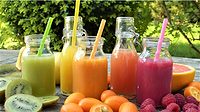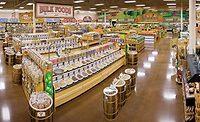Children's drinks address growing concerns
Children’s drinks leverage natural, reduced sugar claims



Country Pure Foods’ Juice4U! line is a 100 percent juice that does not contain preservatives or added sugars.





When it comes to children’s nutrition, parents are faced with the challenge of finding products that meet their nutritional preferences, but also appeal to their children. But the challenge extends beyond parents and begins with the manufacturers. Beverage-makers are tasked with developing products to help bridge the gap between nutritional demands and pleasing taste profiles.
In a May 2011 report titled “Kids Food and Beverage Market in the U.S.,” market research publisher Packaged Facts anticipated a 40 percent increase in the children’s food and beverage market from 2010 to 2015. The report cited beverages as the second largest market for retail sales, trailing only the frozen foods segment.
Although the Packaged Facts report suggested growth for the children’s food and beverage market, new product introductions have seen a decline. In 2006, a little more than 100 kids beverages were introduced, but in 2011, releases were down to a little less than 70 products, says Sarah Theodore, global drinks analyst for Chicago-based Mintel Food & Drink.
Designed for kids
Currently, the kids beverage market is highly composed of products from the juice and juice drinks category. “They account for about a third of the new product launches that are aimed at that particular age group, but kids products are also fairly popular in powdered drink mixes, drinking yogurt and flavored milks,” Theodore says.
Among the reasons why these categories resonate with the children’s beverage market are familiarity and nutritional value. Kids can be picky eaters and drinkers, so these categories lead the new product introductions because they are the ones most likely to succeed, Theodore says.
“Juice and milk are products that kids are really familiar with, so those tend to be where the introductions come from, and also where parents look for kids drinks because they have some inherent nutritional value,” she says. “They feel better about buying a juice-based product because it has juice content or dairy because they’re giving their kids calcium or protein.”
According to a July 2011 Mintel report on juice and juice drinks, approximately 97 percent of children between the ages of 6 and 11 report consuming any juice or juice drinks; 94 percent are likely to drink other juices and lemonades; and 85 percent choose orange juice. The report also states that natural and healthy product claims saw above average activity in the children’s juice and juice drinks segment.
“No additives or preservatives” accounted for the largest number of health-related product claims in 2011, with nearly half of children’s beverage products claiming this attribute, Theodore says. This attests to a growing desire for natural products that do not contain artificial ingredients, she adds.
Helps Teas, New York City, recently released its Helps Kids Teas, a line of 100 percent natural medicine herbal teas for children. The lineup features four functional teas: For Little Tummies, a blend of chamomile flowers, anise and lemon balm for stomach aches; Dreams, a combination of rooibos and lemon balm for calming and relaxing benefits; Rehydration Diets, a blend of dog rose, bilberry and anise for proper rehydration; and Breathe, a combination of linden, thyme, fennel, elder and mallow to help children breathe easier while suffering from a cold.
“The Helps Kids Teas line is intended to help [children] deal with different issues while enjoying [the beverage],” says Iban Abou, sales manager with Helps Teas. “We have included some herbs and fruits to make it taste better for the little ones.”
Helps Teas also offers functional teas for adults, but sees potential in the children’s beverage market. “In our opinion, the kids market is in full development right now — it’s not as fast as in the adult one, but it’s growing at a steady pace,” Abou says. “We prepare for a future where we believe kids will be great consumers of healthier drinks by being proactive and working on this market through its developing stages.”
Last year, Irvine, Calif.-based Orgain Inc. expanded its line of Orgain ready-to-drink nutritional shakes with the introduction of Orgain Healthy Kids. The U.S. Department of Agriculture (USDA)-certified organic product is made with certified organic fruits and vegetables, the company says.
Seth Goldman, president and TeaEO of Honest Tea, a wholly-owned subsidiary of Atlanta-based The Coca-Cola Co., anticipates organic products will continue to grow in the kids beverage market.
“This energy around organics is only going to continue to grow because with all the concerns we’re hearing [about] — not just food quality, but food safety — organics is just one further step a parent can take to help protect their kids and make sure there’s integrity and transparency in the food supply,” he says.
Honest Tea’s Honest Kids line of organic thirst quenchers sold in pouches has seen its market share grow at retailers. At some retailers, Honest Kids’ share of overall sales for the kids drink market is in the high teens, Goldman says.
“That’s exciting because that means we’re getting a great share and it’s suggestive of where the overall food industry will be as people move more toward organic diets,” he adds.
Not so sweet
Some companies are highlighting a less sweet side to their children’s products. Since 2006, low-, no- or reduced-sugar claims increased from being in 24 percent of new product introductions to 38 percent, Mintel’s Theodore says.
Honest Kids pouches contain 40 calories and less sugar than most other pouch drinks, Goldman says. The shift toward fewer calories and less sugar is another trend that Goldman is excited to see in the industry.
“What we’ve shown is you can give a kid a 40-calorie drink, and if you can make it taste good and make the packaging fun and engaging, they’ll drink that,” he says. “From a parent’s perspective, it’s nice to know that there are lower-calorie options that kids will consume.”
Venturing into the bottled water category, Wat-aah!, New York City, designed a portfolio of waters to appeal to children, which has seen strong growth within its distribution network. Its functional waters are free of sugar and other sweeteners.
“Wat-aah! took on the challenges that came with marketing water to kids and filled the void by creating a brand that appeals to them and speaks in their terms,” says Rose Cameron, founder and chief executive officer of Wat-aah! “Wat-aah! employs innovative and contemporary marketing approaches unique enough to get their attention.”
Among those approaches was being the official partner and beverage sponsor of R&B singer Beyonce Knowles’ Let’s Move! Flash Workout! global event in 2011. The event was part of an initiative created for First Lady Michelle Obama’s Let’s Move! campaign, which promotes physical activity and healthy nutrition to kids.
Cameron says that beverages can play an important role as consumers look to address health issues, such as childhood obesity. “With sugar being viewed as one of the main contributors to childhood obesity, there’s an increasing demand for healthier, lower-calorie, lower-sugar products, especially for children,” she says. “These trends are here to stay, meaning an increase in the kids beverage market is sure to follow suit as these issues continue to pick up steam.”
Even though parents can control what children consume within the home, the challenge remains of getting them to consume healthy, low-calorie beverages outside of the home, specifically in schools.
Last year, Akron, Ohio-based Country Pure Foods added new flavors Citrus Blast and Twisted Melon to its Juice4U! line of 100 percent juice products for the foodservice channel, which contain no added preservatives and sugars.
Also available in the schools channel is 4U2U Brands LLC’s Fruit 66, a low-calorie, juice-based product line that is fortified with five vitamins and minerals. In order to keep the calories low, Fruit 66 is comprised of 75 percent juice and 25 percent water, says Bill Hargis, president and chief executive officer of 4U2U Brands.
When developing Fruit 66, the company worked with the USDA, Institute of Medicine, School Nutrition Association as well as a number of foodservice directors to find out what schools and kids needed in a beverage option, which turned out to be a low-calorie beverage with essential nutrients and vitamins, Hargis says.
By comprising Fruit 66 of 25 percent water to bring down the calories, it also brought down the sweetness of the product, he adds. The company conducted tests that compared its products to others that are sweeter and higher in calories and found that kids showed a preference for the less sweet varieties, Hargis says.
“I honestly was nervous because I thought they were going to gravitate toward the sweeter drinks … and [that] wasn’t the case,” he says. “It was so rewarding to see that because there was a lot of stuff hanging on that — trying to provide something that the schools said that they wanted for the kids, but also meeting the kids’ taste requirements.” BI
Looking for a reprint of this article?
From high-res PDFs to custom plaques, order your copy today!










